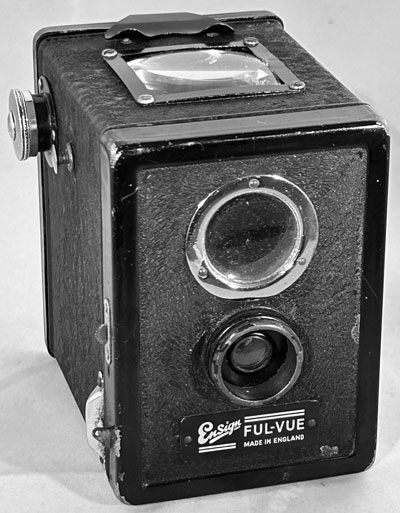Ensign Ful-Vue
Specification

| Manufacturer | : | Ensign |
|---|---|---|
| Produced | : | 1939 |
| Classification | : | Medium Format |
| Body Type | : | Pseudo Twin Lens Reflex |
| Construction | : | Metal |
| Film Type | : | 120 |
| Film Width | : | 62mm |
| Image Size | : | 2¼ x 2¼ in |
| No. of Images | : | 12 |
| Lens Type | : | All distance |
| Focal Length | : | 90mm |
| Focus Type | : | Variable |
| Focal Range | : | 3ft - inf. |
| Aperture Type | : | fixed |
| Aperture | : | f/16 |
| Shutter Type | : | Rotary |
| Shutter Speeds | : | I*(1/40 sec), T(Bulb) |
| Size (w x h x d) | : | 80 x 105 x 100 mm |
| Weight | : | 531g |
| * Measured on this camera | ||
Art Deco Credentials
![]()
Limited: Minor and insubstantial
- Produced during the main Art Deco period.
- Chrome winder, viewfinder surround and shutter lever guard
- Pressed steel body with 'X' pattern on back.
Description
Early in 1939, Ensign Ltd. introduced what was to become one of Britain's most popular cameras and now regarded by many as a design classic. It was designed in the Bauhaus tradition of 'form follows function'. Its large reflex viewfinder gave the photographer a much brighter view than was previously provided by contemporary cameras - hence the name Ful-Vue. The mirror for the view finder was not made of mirrored glass but a polished metal plate. The camera can be described as a pseudo twin lens reflex camera. It isn't a true TLR because the top lens is just part of the viewfinder and does not aid focussing.
It is equipped with the patent Ensign 'all distance lens' which enabled close-up photography down to a distance of 3 feet by means of a pull out lens mount. The camera gives twelve 6 x 6cm pictures on a 120 roll film.
The film transport system is accessed by a catch at the back. A knob is used to advance the film and proper framing is acheived by the use of a red window on the rear of the camera.
It has a simple I/T shutter with a shutter lever guard. The shutter speed is fixed at about 1/40s with the aperture fixed at f/16. The rotary shutter is released by pushing a lever down at the side. A switch provides for 'timed' shutter mode.
How to Use
This camera takes 120 film which is easily available from photographic outlets.
If you don't want to bother with an exposure meter, follow the guide shown. It is based on the 'Sunny 16' rule. Film is so forgiving and will produce acceptable results even when overexposed by 2 or 3 stops or underexposed by 1 stop.
Remember that the exposure guide in the camera user manual may not be helpful as it is based on the use of old film with a low ISO value.
The tables assume that the sun is at least 30 degrees above the horizon - that's 10am - 5pm on a summer's day (May-August) in the UK.
This camera has an f/16 aperture and a shutter speed of about 1/40s
The slow shutter speed means that you need to hold this camera steady when taking photographs.
With modern film, this window must be covered with black tape except when moving to next frame in subdued light.
Using ISO 100/125 film - shutter speed 1/40s
| Weather Conditions | Shadow Detail | Aperture | Exposure |
|---|---|---|---|
 Sunny SunnySnow/Sand | Dark with sharp edges | f/16 | +2 Stops Overexposed Acceptable |
 Sunny Sunny | Distinct | f/16 | +1 Stops Overexposed Acceptable |
 Slight Overcast Slight Overcast | Soft around edges | f/16 | Good |
 Overcast Overcast | Barely visible | f/16 | -1 Stop Underexposed Acceptable |
 Heavy Overcast Heavy Overcast | None | f/16 | -2 Stop Underexposed Not Acceptable |
 Open Shade Open Shade/Sunset | None | f/16 | -3 Stops Underexposed Not Acceptable |